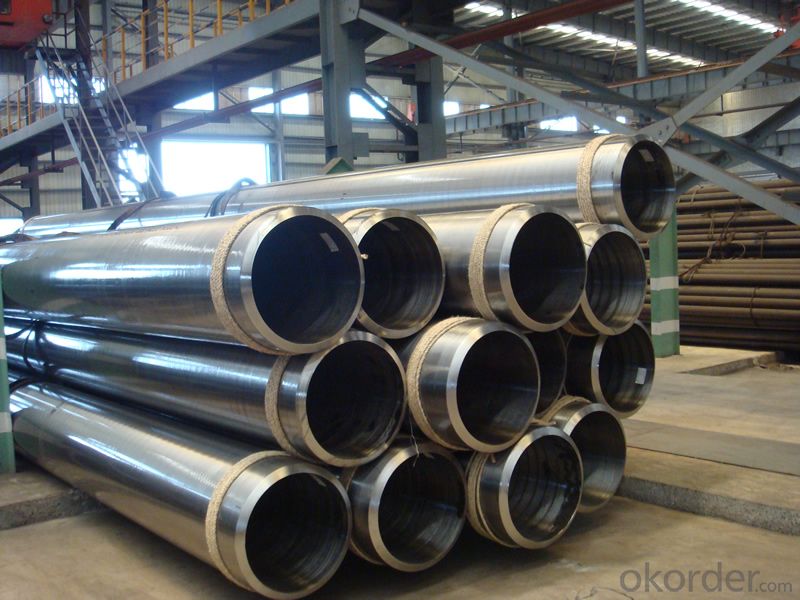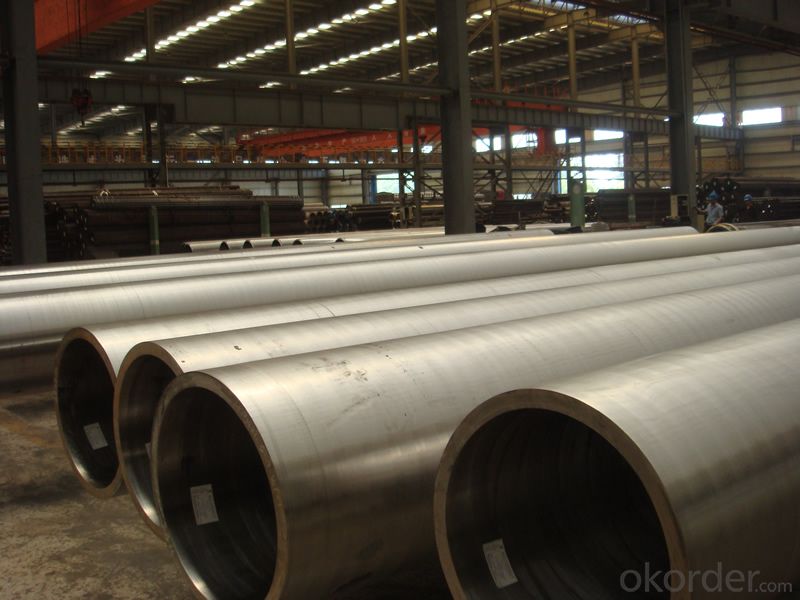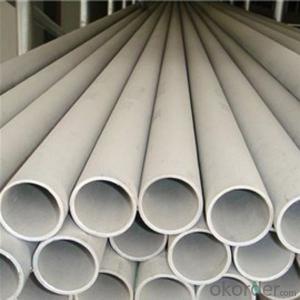Stainless Steel Welded Pipe ASTM A358/A312/A778
- Loading Port:
- Ningbo
- Payment Terms:
- TT or LC
- Min Order Qty:
- 25 m.t.
- Supply Capability:
- 8000 m.t./month
OKorder Service Pledge
OKorder Financial Service
You Might Also Like
1、Structure of Stainless Steel Welded Pipe ASTM A358/A312/A778 Description:
Stainless steel welded pipe is actually a cover term, covering a wide range of alloy and making them suitable for different attributes that are used in a very wide and large numbers of different industries. Stainless steel pipe is resistant to erosion, highly flexible, powerful, easy to use, and can be done in distinct approaches, which means that more and more stainless steel was used as a construction material for large-scale, high impact buildings. It can be molded, rolling, and it can create amazing shapes to make it perfect, It is used as experimental buildings, The use of steel pipe welding of large stainless steel covers other examples.
2、Main Features of the Stainless Steel Welded Pipe ASTM A358/A312/A778:
• High manufacturing accuracy
• High strength
• Small inertia resistance
• Strong heat dissipation ability
• Good visual effect
•Reasonable price
3、Stainless Steel Welded Pipe ASTM A358/A312/A778 Images:



4、Stainless Steel Welded Pipe ASTM A358/A312/A778 Specification:
Size:
| Outside diameter | Outside | Thickness | ||||
| SCH 5S | SCH 10S | SCH 20S | SCH 40S | |||
| (A) | (B) | mm | mm | mm | mm | mm |
| 350 | 14′ | 355.6 | 3.96 | 4.78 | 7.92 | 11.13 |
| 400 | 16′ | 406.4 | 4.19 | 4.78 | 7.92 | 12.7 |
| 450 | 18′ | 457.2 | 4.19 | 4.78 | 7.92 | 14.27 |
| 500 | 20′ | 508.0 | 4.78 | 5.54 | 9.53 | 15.09 |
| 550 | 22′ | 558.8 | 4.78 | 5.54 | 9.53 | 15.09 |
| 600 | 24′ | 609.6 | 5.54 | 6.35 | 9.53 | 17.48 |
| 650 | 26′ | 660.4 | 5.54 | 7.92 | 12.7 | 17.48 |
| 700 | 28′ | 711.2 | 5.54 | 7.92 | 12.7 | 17.48 |
| 750 | 30′ | 762.0 | 6.35 | 7.92 | 12.7 | 17.48 |
| 800 | 32′ | 812.8 | 7.90 | 12.7 | 17.48 | |
| 850 | 34 | 863.6 | 7.92 | 12.7 | 17.48 | |
| 900 | 36′ | 914.4 | 7.92 | 12.7 | 19.05 | |
| 1000 | 40′ | 1016.0 | 9.53 | |||
Tolerances on dimensions table:
| Standard | Outside(mm) | Thickness(mm) | Length(mm) | |
| ASTM A312 | ≤48.26 | +0.40 -0.80 | +No special provisions(Unspecified)-12.50% | Appoint LengthDefinite cut length+6.40 -0 |
| >48.26~114.30 | +0.80 -0.80 | |||
| >114.30~219.08 | +1.60 -0.80 | |||
| >219.08~457.20 | +2.40 -0.80 | |||
| >457~660 | +3.20/-0.80 | |||
| >660~864 | +4.00/-0.80 | |||
| >864~1219 | +4.48/-0.80 | |||
| JIS G3459 | <30.00 ±0.30≥30.00 ±1.00% | <2.00 ±0.20≥2.00 ±10% | Appoint LengthDefinite cut Length | |
| GB/T 12771 | <13.00 ±0.2013.00~40.00 ±0.30≥40.00 ±0.80% | ≤4.00 +0.50 -0.60>4.00 ±10% | +20.00-0 | |
| EN 10217-7 | D1±1.50% with±0.75mm(min)D2±1.00% with±0.50mm(min)D3±0.75% with±0.30mm(min) D4±0.5% with±0.10mm(min) | T1±15.00% with±0.60mm(min)T2±12.5% with±0.40mm(min)T3±10.00% with±0.20mm(min) T4±7.50% with±0.15mm(min) T5±5.00% with±0.10mm(min) EN ISO 1127 | ≤6000 +5.00 -06000~12000 +10.00 -0 | |
5、FAQ of Stainless Steel Welded Pipe ASTM A358/A312/A778:
①How is the quality of your products?
Our products are manufactured strictly according to national and internaional standard, and we take a test on every pipe before delivered out. If you want see our quality certifications and all kinds of testing report, please just ask us for it.
Guaranteed: If products’ quality don’t accord to discription as we give or the promise before you place order, we promise 100% refund.
②How about price?
Yes, we are factory and be able to give you lowest price below market one, and we have a policy that “ for saving time and absolutely honest business attitude, we quote as lowest as possible for any customer, and discount can be given according to quantity”,if you like bargain and factory price is not low enough as you think, just don’t waste your time.Please trust the quotation we would give you, it is professional one.
③Why should you chose us?
Chose happens because of quality, then price, We can give you both.Additionally, we can also offer professional products inquiry, products knowledge train(for agents), smooth goods delivery, exellent customer solution proposals.Our service formula: good quality+good price+good service=customer’s trust
SGS test is available, customer inspection before shipping is welcome, third party inspection is no problem.
Any question, pls feel free to contact us !
- Q:What brand of stainless steel pipe cutting machine is good?
- That choose the cutting way, to me the tool pipe cutting manner is also a very good method, small caliber selection automatic instrument lathe, large caliber SOONFAN anti vehicle type cut pipe (pipe does not turn the rotary knife type), of course, saw blade, saw blade, laser, plasma and other methods can be used, for example to decide according to their own conditions for pipe cutting.
- Q:What is the difference between polished and unpolished stainless steel pipes?
- Polished and unpolished stainless steel pipes differ primarily in their appearance and surface finish. Polished stainless steel pipes have undergone a polishing process that enhances their aesthetic appeal by creating a smooth, shiny, and reflective surface. This process involves using abrasive materials or compounds to remove any imperfections, scratches, or blemishes on the stainless steel surface. On the other hand, unpolished stainless steel pipes have a rougher, duller, and more industrial-looking surface. They have not been subjected to the polishing process and therefore retain their original surface finish, which may include slight imperfections, scratches, or a matte appearance. The choice between polished and unpolished stainless steel pipes depends on the desired application and aesthetic preference. Polished stainless steel pipes are commonly used in industries such as architecture, interior design, and food processing, where a visually appealing and hygienic surface is required. Unpolished stainless steel pipes, on the other hand, are often used in applications where appearance is not a priority, such as industrial or structural uses. It is important to note that the performance and durability of both polished and unpolished stainless steel pipes are comparable, as the polishing process does not affect the inherent corrosion resistance and strength of the stainless steel material. Ultimately, the decision between polished and unpolished stainless steel pipes relies on the specific requirements and intended use of the pipes.
- Q:What is the impact strength of stainless steel pipes?
- The impact strength of stainless steel pipes is generally high, as stainless steel is known for its toughness and resistance to impact and deformation. However, the exact impact strength can vary depending on the specific grade and manufacturing process of the stainless steel used in the pipes.
- Q:What is the average lifespan of stainless steel pipes?
- The average lifespan of stainless steel pipes can vary depending on various factors such as the quality of the materials used, the environment in which they are installed, and the maintenance practices followed. However, on average, stainless steel pipes can last anywhere from 50 to 100 years or more with proper care and maintenance.
- Q:What is the difference between 304N and 316N stainless steel pipes?
- The main difference between 304N and 316N stainless steel pipes lies in their composition and properties. 304N stainless steel is a variant of the 304 grade, which is one of the most commonly used stainless steel alloys. It contains a higher nitrogen content, which enhances its strength, corrosion resistance, and resistance to pitting and crevice corrosion. This makes it suitable for applications where higher strength and resistance to corrosion are required, such as in the chemical and petrochemical industries. On the other hand, 316N stainless steel is a variant of the 316 grade, which is known for its excellent corrosion resistance and high temperature strength. Similar to 304N, the addition of nitrogen in 316N stainless steel improves its strength and corrosion resistance. It also exhibits better resistance to pitting and crevice corrosion compared to 304N stainless steel. 316N stainless steel is commonly used in applications where superior corrosion resistance is necessary, such as in marine environments and medical equipment manufacturing. In summary, while both 304N and 316N stainless steel pipes offer improved strength and corrosion resistance compared to their non-N counterparts, 304N is more suitable for general-purpose applications where moderate corrosion resistance is required, while 316N is preferred for environments with higher levels of corrosion and in applications where superior resistance to pitting and crevice corrosion is necessary.
- Q:Can stainless steel pipes be cut to length?
- Yes, stainless steel pipes can be cut to length.
- Q:Can stainless steel pipes be insulated with polycaprolactone?
- Stainless steel pipes can indeed be insulated with polycaprolactone. Polycaprolactone, also known as PCL, is a thermoplastic polymer that has excellent thermal insulation properties. It has a low thermal conductivity, which makes it an effective choice for insulating pipes and preventing heat loss or gain. Additionally, PCL is also resistant to moisture and chemicals, making it suitable for various environments and applications. When applied as insulation on stainless steel pipes, polycaprolactone can help maintain the desired temperature, reduce energy consumption, and prevent condensation.
- Q:How do you prevent scaling in stainless steel pipes?
- One way to prevent scaling in stainless steel pipes is by using a process called passivation. Passivation involves treating the stainless steel surface with a mild oxidant or acid solution to remove any contaminants and create a protective oxide layer. Regular cleaning and maintenance, avoiding prolonged exposure to high temperatures, and controlling the water chemistry are also effective measures to prevent scaling in stainless steel pipes.
- Q:What are the disadvantages of using stainless steel pipes?
- While stainless steel pipes offer numerous advantages, there are a few disadvantages to consider: 1. Cost: Stainless steel pipes tend to be more expensive than other pipe materials such as PVC or carbon steel. This higher cost can impact the overall budget for a project. 2. Corrosion Resistance Limitations: While stainless steel is known for its corrosion resistance, it is not completely immune to corrosion. In certain environments, such as highly acidic or alkaline conditions, stainless steel pipes can still corrode over time. 3. Brittle: Stainless steel pipes can be more brittle than other materials, which makes them more susceptible to cracking or breaking under extreme temperatures or stress. This can be a concern in applications where the pipes are subjected to significant pressure or thermal fluctuations. 4. Difficult to Modify: Compared to other pipe materials, stainless steel pipes are harder to modify or alter once they are installed. This can be problematic if any changes or adjustments need to be made in the future, as it may require more time and effort. 5. Heat Conductivity: Stainless steel has lower heat conductivity compared to materials like copper. This means that stainless steel pipes may not transfer heat as efficiently, which can be a disadvantage in some applications where heat transfer is important. Overall, while stainless steel pipes have numerous benefits, it is important to consider these disadvantages when selecting the appropriate material for a specific project.
- Q:How do stainless steel pipes perform in extreme weather conditions?
- Stainless steel pipes are known for their excellent performance and durability in extreme weather conditions. Due to their unique composition, stainless steel pipes have a high resistance to corrosion, making them ideal for use in various environments, including extreme weather conditions. In extremely cold weather, stainless steel pipes retain their strength and flexibility, unlike other materials that may become brittle or crack. This makes them suitable for applications such as oil and gas pipelines, where they can withstand low temperatures without compromising their performance. Similarly, in extremely hot weather, stainless steel pipes exhibit excellent heat resistance, preventing them from warping or deforming. This quality is crucial in industries like power generation, where high-temperature environments are common. Furthermore, stainless steel pipes have a high melting point, enabling them to maintain their structural integrity even in the presence of intense heat. This makes them resistant to fire damage, making them a safe choice for applications that require fire protection. Stainless steel pipes also have exceptional resistance to UV radiation, which can be damaging over time. This property ensures that the pipes do not degrade or weaken when exposed to direct sunlight or extreme weather conditions, making them suitable for outdoor applications. Additionally, stainless steel pipes have excellent mechanical properties, including high tensile strength and impact resistance. These qualities allow them to withstand extreme weather conditions such as high winds, heavy storms, and seismic activities without undergoing structural failures. In conclusion, stainless steel pipes are highly reliable and perform exceptionally well in extreme weather conditions. Their resistance to corrosion, high and low temperatures, UV radiation, and mechanical stress makes them a preferred choice for various industries, ensuring reliable and long-lasting performance even in the harshest environments.
1. Manufacturer Overview |
|
|---|---|
| Location | |
| Year Established | |
| Annual Output Value | |
| Main Markets | |
| Company Certifications | |
2. Manufacturer Certificates |
|
|---|---|
| a) Certification Name | |
| Range | |
| Reference | |
| Validity Period | |
3. Manufacturer Capability |
|
|---|---|
| a)Trade Capacity | |
| Nearest Port | |
| Export Percentage | |
| No.of Employees in Trade Department | |
| Language Spoken: | |
| b)Factory Information | |
| Factory Size: | |
| No. of Production Lines | |
| Contract Manufacturing | |
| Product Price Range | |
Send your message to us
Stainless Steel Welded Pipe ASTM A358/A312/A778
- Loading Port:
- Ningbo
- Payment Terms:
- TT or LC
- Min Order Qty:
- 25 m.t.
- Supply Capability:
- 8000 m.t./month
OKorder Service Pledge
OKorder Financial Service
Similar products
New products
Hot products
Related keywords




























